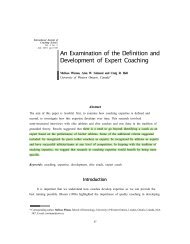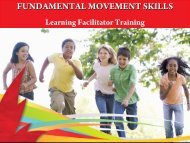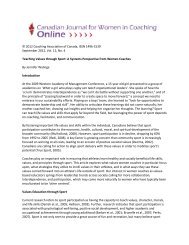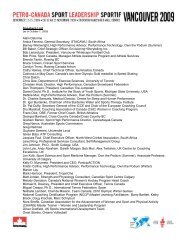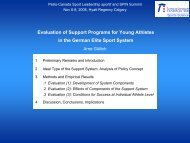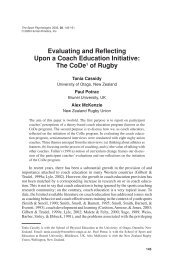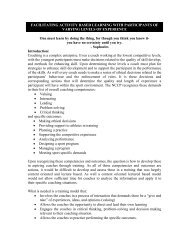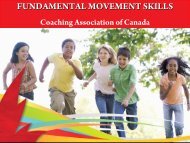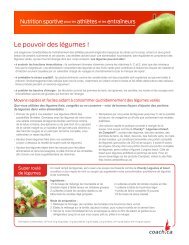Coaching Athletes with a Disability - Coaching Association of Canada
Coaching Athletes with a Disability - Coaching Association of Canada
Coaching Athletes with a Disability - Coaching Association of Canada
- No tags were found...
You also want an ePaper? Increase the reach of your titles
YUMPU automatically turns print PDFs into web optimized ePapers that Google loves.
<strong>Coaching</strong> <strong>Athletes</strong> <strong>with</strong> a <strong>Disability</strong>Part oneStages coaches may go through when working for the first time <strong>with</strong> an athlete <strong>with</strong> a disabilityComments from expert coachesJean Laroche has coached some <strong>of</strong> <strong>Canada</strong>’s greatest wheelchair athletes in track and field,including André Viger and Diane Roy. He has also coached able-bodied athletes in several sports,including hockey and soccer. “My first experience <strong>with</strong> athletes <strong>with</strong> a disability was a surprise; Ididn’t really know what to do,” Laroche says. “I really had to sit down and learn about theirsituation.” Laroche says that coaches must have the right attitude when coaching a person <strong>with</strong>a disability for the first time. “You have to be open-minded,” he says. “For my part, I didn’t haveany preconceived ideas. I tried to work <strong>with</strong> the abilities they did have and I treated them right<strong>of</strong>f the bat as athletes. In able-bodied sports, a kayaker doesn’t train the same way as a highjumper. So for me, that’s how I viewed the situation.”Peter Eriksson, an award-winning national team and international wheelchair racing coachwhose stable <strong>of</strong> athletes includes quintuple Canadian Paralympic champion Chantal Petitclercand world record holder Jeff Adams, says that coaches should simply remember at first that theyare coaches. Eriksson has coached athletes to more than 100 medals at the Paralympic Gamesover the last 20 years. “You’re not there to be a nurse or a helper,” says Eriksson, the firstCanadian wheelchair coach to be certified at the highest level <strong>of</strong> the National <strong>Coaching</strong>Certification Program in track and field. “It’s important to do what you would <strong>with</strong> any otherathlete at first, such as determining their fitness levels, identifying what skills need to beimproved, and educating them about good training. You should look at coaching the person <strong>with</strong>a disability as an opportunity to help her or him develop in the sport.”Dino Pedicelli has been coaching athletes <strong>with</strong> an intellectual disability for over 25 years. Duringthis time, he has coached virtually all Special Olympics sports, but he now focuses primarily onfloor hockey. “These athletes must be treated the same way any other athletes <strong>of</strong> the same agewould be. Adults must not be dealt <strong>with</strong> as though they were children” he insists. “It is some timesnecessary for the coach to adjust, and to talk at a level they can understand, but this only meansthat instructions must be simple and clear”. Pedicelli describes his approach this way: “As a coach,I like to give the athletes a chance to show what they can do. Then, my job is to design activitiesto improve their skills and their ability to perform”.1© <strong>Coaching</strong> <strong>Association</strong> <strong>of</strong> <strong>Canada</strong>, 2005 6



